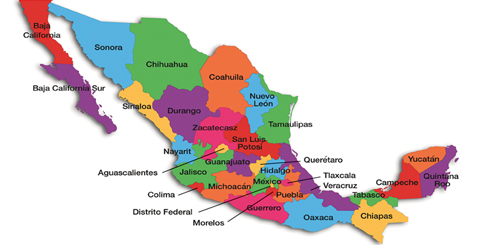Geography and climate
When it comes to climate and geography, every growing region boasts something different. Such variations guarantee year-round cultivation and a steady supply of exportable crops from somewhere in Mexico (for a more in-depth look at climates and microclimates, see our sidebar on the next page).
The Baja Peninsula, for example, is sunny, arid, and occasionally rain-starved with an ideal climate and terrain for certain crops like grapes, berries, and peppers.
Then there’s the Yucatán Peninsula, with the states of Yucatán, Campeche, and Quintana Roo. With thinner soil and semitropical weather, these states are better suited to growing squash, beans, and various root vegetables. This particular region is far better known for its resorts and beaches than fruit and vegetable production.
Growers in the northern and northwestern states of Chihuahua, Coahuila, Sonora, and Sinaloa all employ irrigation systems, as the area is dry despite regular rain during the winter.
Along the Pacific coast are the states of Nayarit, Michoacán, Guerrero, and part of Jalisco, which count many popular tourist destinations like Puerto Vallarta and Acapulco among their better known cities.
South and Central
Further south, the states of Oaxaca and Chiapas, both home to large indigenous populations, range from semi-arid plateau and rainforest to mountainous highlands (at press time, this region had experienced a deadly earthquake near Chiapas and Oaxaca, the worse to hit the country in nearly a century).
Located on the Gulf of Mexico are the produce-growing states of Veracruz and Tamaulipas, and in the central part of the country is El Bajío, which includes the states of Querétaro, Guanajuato, Aguascalientes, and parts of Jalisco.
The Mother of All Markets
Nowhere is the proliferation of produce more evident than at La Central de Abasto wholesale center in Mexico City, the country’s capital most populous metropolitan area.
La Central de Abasto opened on the east side of the capital city in 1982 to help ease the overflowing consumer and business traffic at downtown’s Merced Market, the city’s main market.
Since then, La Central has grown to become one of the largest food markets in the world. More than 30,000 tons of food—about 30 percent of all the food consumed around Mexico—passes through the market every day.
Spread out over 778 acres, La Central is home to more than 2,000 small and large businesses, many of which still operate on a cash-only basis.



